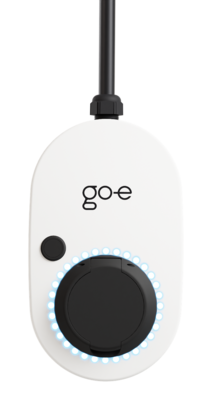Is There Enough Electricity for Electric Cars?
The Federal Motor Transport Authority reported that Germany surpassed one million battery-powered vehicles in 2022, marking a continuous upward trend. But, can we handle charging all these new electric cars with our current electricity setup?
Charging a lot of cars at the same time, as it often happens at peak hours when people come home from work and plug in their vehicles, can be a challenge for the local power grids. Compared to regular home appliances like your washing machine or computer, EVs need much more electricity, and they need it for a longer time. So, what does the future with electric vehicles look like?
Current Energy Landscape for EV Charging
As you already know, switching to electric cars and other types of electric transportation (e.g. electric buses) means we need significantly more electricity. Actually, it's not just e-mobility that boosts power demand. Shifting homes to electric heat pumps, as part of decarbonization, will also greatly increase electricity needs. All in all, in the future, we need a lot of energy for various things.
But for now, let's focus on how the development of electric vehicles will affect the energy landscape.
You may have a lot of concerns. About the high demand for energy, rising electricity prices and the impact of all these developments on the environment. After all, it's not just a few Teslas you occasionally see on the roads, but the entire vehicle fleet is gradually being converted to electric drive.

The surprising thing is that it is actually a positive trend, not a negative one.
Electric vehicles are super efficient when it comes to using energy and this is their head start over the cars with regular engines. This means with e-mobility spreading all over the globe, we can reduce the overall amount of energy we use by going from vehicles with an internal combustion engine to electric ones. In fact, over the lifetime of a car, if it's powered by clean electricity, it uses about 50% less energy than a regular petrol car.
Here's why:
-
Regular cars are not so good at using the fuel they get. Only about 25% (!) of the energy in the fuel actually goes into making the car move (from the tank to the wheels). The rest is lost as heat - puff. But with electric cars, a lot more of the electricity they get can go into making them move—about 85%.
-
Another fascinating thing about electric cars is that when you hit the brakes, they can turn some of the energy back into electricity for the car's battery. It's called recuperation and it’s basically like recycling energy when you slow down. How can you not fall in love with e-mobility after that?
Note: In 2009, the US Department of Energy determined that producing one litre of fuel in a refinery demands approximately 1,585 kilowatt hours, a finding precisely validated by the GEMIS database. Let’s assume you drive a car that consumes seven litres of fuel per 100 kilometres, the energy used to make that fuel would be over 11 kilowatt hours. This amount of energy could power an electric car for 50-80 kilometres.
If a million more electric cars hit the roads, they might need only about 3.6% more electricity. Imagine if 10% of all cars in a place like Austria were electric - then the extra electricity needed would be just 1.8%. So, even though more electric cars mean a higher electricity demand, it's not as much as you might think, and it's way better for the environment.
And let’s not forget, switching to electric vehicles completely won't happen overnight. In 2030, approximately 15% of the European vehicle fleet is projected to consist of zero-emission light vehicles and trucks. By 2040, electrified vehicles are expected to make up over 30% of the overall fleet for both light vehicles and trucks. However, the lion's share of vehicles on European roads in 2040 will still be the ones with an internal combustion engine (ICE). All in all, it will take a significant amount of time to replace the entire existing fleet. This means the electricity industry has time to adjust to the increasing demand for electric power.
Renewable Energy Solutions
To make sure electric cars are good for the environment, we need to produce the electricity they use in a way that's friendly to our planet. Since 2016, more power plants that use renewable energy (like solar and wind) have been built worldwide than the ones that use fossil fuels or nuclear energy combined. Using more renewables is also making them cheaper. For instance, solar power costs might drop by 40-70%, and onshore wind power by 10-25% in the coming years.
The way we get our energy is changing a lot, thanks to things like solar power, wind energy, and heat pumps. The experts at the International Energy Agency say that by 2030, almost half of the electricity around the world will come from these clean sources. Right now, they make up about 30%.
Note: If you put a 2.6 kW peak solar panel on your roof and use it solely for charging your electric car, it can generate around 2,600 kWh per year, enough to power an electric car for about 13,000 km. Keep in mind that these numbers are average values for Germany, and the daily output can vary due to factors like sunlight, weather, and where you are located. Most of the power, about 70%, comes during the summer months.
Green energy for electric cars in Austria
Right now, in Austria and across Europe, there's a high demand for electricity, and it's straining the system.
Even without many electric cars, the electricity grid is under pressure. Austria has to import electricity sometimes so that there is enough available at peak times. The good news is that the electricity supply is stable. The main issue with the grids is that the demand for power is constantly changing. You see, electricity has to be consumed as soon as it is generated, and that is a challenge. One solution is to invest in increasing the total capacity of electricity generation nationwide by 1.9 gigawatt hours.
This means not only building more power plants, but also expanding the power lines. For example, if wind energy is generated in one place (e.g. Lower Austria), it should be channelled efficiently to where it is needed (e.g. Tyrol).
At the moment, we cannot store large amounts of electrical energy. This means that we have to generate exactly the amount of electricity that corresponds to the current demand at any given time. To do this, we need to be wizards with a special power to see the future. 🧙♂️ With the increasing use of renewable energy sources that can be unpredictable (e.g. solar or wind), there might be periods when there is too much or too little electricity. This puts strain on the grid and increases the risk of localised blackouts. To counteract this, new solutions are needed to efficiently store electricity for when it is needed, as it becomes increasingly difficult to balance constant supply and demand. When it comes to EV charging, some of such solutions include load shifting, peak shaving and bidirectional charging. We will talk about it later.
A recent study from Vienna University of Technology suggests that by 2030, Austria could meet 100% of its electricity needs with renewable energy, without significant extra costs. This transition could create 53,000 jobs, reduce annual greenhouse gas emissions by 17.5%, and save 210 million euros on emission certificates. Even with a modest 30% share of electric cars by 2030, the switch to cleaner energy seems feasible.
Note: Austria currently obtains an impressive 75 percent of its electricity from renewable sources, a noteworthy accomplishment that stands favourably in international comparisons. However, this varies from country to country. For instance, the U.S. Energy Information Agency suggests that just under 1% of Saudi Arabia's electricity is derived from renewable sources.
Energy demand for electric vehicles in Germany
The data suggests a positive trend in Germany's renewable energy growth, especially in the electricity sector. The increasing share of renewables in electricity generation, along with a surplus of green energy in 2022, indicates the potential to support the rising demand coming from electric vehicles.
Imagine if every vehicle in Germany was an electric vehicle. In 2020, this would equate to approximately 45 million electric cars. According to the Federal Ministry for the Environment, Nature Conservation, Nuclear Safety and Consumer Protection, in that case, the demand for electricity would only go up by around 20%, which is not a huge jump. With renewable electricity covering 46.2% of the country's gross electricity consumption, there seems to be enough capacity to meet this demand.
The amount of electricity itself isn't the issue. Currently, experts are focusing on optimising power grid usage rather than exploring energy storage solutions.
Smart and Grid-Compatible Charging as a Solution
In addition to using renewable sources of energy, we need to manage use of the energy efficiently. And that’s where smart charging comes into play.
Load shifting
Right now, electric cars can be charged at night when electricity demand is low. This is possible with smart wallboxes which allow you to schedule charging. Such a strategy is called load shifting and is widely employed for adding to the stability of the power grid.

For instance, with our go-e Charger, you can schedule charging to the night hours in the go-e app and go to bed at any time you want - charging will automatically start and finish at the specified time.
go-e Charger Gemini 11 kW

The compact wallbox for stationary use, at home or at the workplace. Simple installation, intuitive operation and smart comfort functions. Charging power from 1.4 kW to 11 kW. 1-phase or 3-phase charging.
go-e Charger Gemini flex 11 kW

The intelligent wallbox can be used both stationary in the wall bracket and mobile. No electrician is required for the installation of the charging station. Charging power from 1.4 kW to 11 kW. 1-phase or 3-phase charging.
go-e Charger Gemini 22 kW

The compact wallbox for stationary use, at home or at the workplace. Simple installation, intuitive operation and smart comfort functions. Charging power from 1.4 kW to 22 kW. 1-phase or 3-phase charging.
go-e Charger Gemini flex 22 kW

The intelligent wallbox can be used both stationary in the wall bracket and mobile. No electrician is required for the installation of the charging station. Charging power from 1.4 kW to 22 kW. 1-phase or 3-phase charging.
To enhance energy efficiency and cost savings, our go-e Chargers feature flexible energy tariffs. The go-e app displays your current energy supplier, enabling the charger to optimise charging during periods of low electricity demand. In "Eco Mode," you can establish a price limit per kWh, prompting the charger to initiate when electricity prices drop below your set threshold. Additionally, the "Next Trip" setting allows you to specify kWh and charging completion time without a price limit, with the go-e Charger automatically selecting the most cost-effective charging hours based on your electricity tariff.
Peak shaving
Peak shaving involves minimising abrupt increases in electricity consumption, known as load peaks, to maintain a balance between energy supply and demand. For instance, during high-demand periods like hot summer days, excessive electricity usage, often from air conditioners, can strain the grid, leading to potential outages. Utilising a smart wallbox like the go-e Charger allows users to set a kW limit for charging, preventing undue stress on the power grid. This strategy scales effectively when employing multiple go-e Chargers, each with its set limit, managed through the go-e app or backend system. For enhanced control, an energy management system, such as the go-e Controller or other compatible systems, monitors the entire building's currents, dynamically adjusting charging power in response to preset limits, changing conditions, and energy requirements.
Bidirectional charging
When it comes to bidirectional charging, you are gonna be dealing with two main terms:
-
Vehicle-to-Grid (V2G) enables electric vehicles to feed energy back to the grid, supporting grid stability.
-
Vehicle-to-Home (V2H) allows the vehicle to power a home, serving as a backup energy source during outages.


Basically, that means that V2G lets your electric car share power with the electric grid, while V2H lets it power your home in case of outages.
Using your electric vehicle as an energy storage device means you are more independent of the power grid. With bidirectional car-to-home charging, you could charge your electric vehicle at night when your computer, dishwasher and washing machine are asleep and the overall demand for electricity in your area is low. You could then use the stored energy to power your own home during the day, when electricity consumption increases. This way, you would not only contribute to the stability of the electricity grid, but also save money due to fluctuating electricity prices.
Unfortunately, bidirectional charging is not the ideal solution... yet. Many new electric vehicles support bidirectional charging, but the lack of compatible software and affordable wallboxes considerably limits their practical benefits. Unfortunately, this situation is unlikely to improve in the near future. Instead, consider more cost-effective and readily available alternatives for the time being, such as smart wallboxes.
PV Surplus Charging with the go-e Charger
While charging your car exclusively with solar power may not always be possible, utilising excess solar energy to charge your car battery can make the charging process more sustainable and also cheaper. Our smart combo, the go-e Charger + go-e Controller, is what you need to make it happen. The go-e Controller, a energy management system (EMS), optimises solar power usage, minimising your reliance on the grid. By monitoring home energy consumption, it initiates car charging automatically when surplus solar power is available. The system intelligently adapts to your solar panel output, offering one or three-phase charging options. Set your preferences in the go-e app, and let the magic of efficient solar charging unfold.
Do you want to allow Integration of youtube videos?
Allows the playback of videos, that are hosted on youtube.com. By allowing this feature, you accept the privacy agreement of google.
Government Initiatives and Policies
Electric vehicles, like conventional ones, pose environmental challenges, which requires a change in travel habits. By 2030, batteries will probably be able to store more energy so that electric cars can travel an average of 600 kilometres or more on a single charge. To achieve this, the design of batteries and cars must be improved, better materials must be used and ways must be found to consume less energy.
The International Energy Agency says that even though renewable energy is growing, fossil fuels, like coal and oil, still get a lot of financial support. The IEA predicts that, based on today's politics, we might use the most coal, oil, and gas by 2025, causing the highest CO₂ emissions. By 2030, these fossil fuels are expected to make up 73% of our energy, down from the usual 80%. However, the IEA warns that we're still using too much fossil fuel if we want to limit global warming to 1.5 degrees Celsius.
Some of the solutions they suggest:
-
doubling the rate of energy intensity improvements;
-
making renewable energy three times bigger globally by 2030;
-
cutting methane emissions from fossil fuels by 75%;
-
investing more in clean energy in poorer countries.
But you don't have to be a politician to make a difference. Switching to an electric car, using a smart charger, and choosing public transport whenever possible instead of driving your own car can make a big difference. These seemingly tiny steps can help pave the way for a sustainable future where we have enough energy for all our needs and more.
Summary
Electric cars come with a lot of benefits. Unlike traditional combustion engines that release around 100 to 140 grams of CO2 per kilometre, electric vehicles produce zero emissions while driving, which makes them environmentally friendly. Additionally, with the implementation of bidirectional charging, they have the potential to act as storage buffers, helping manage peaks in power generation. Smart charging including load shifting and peak shaving which is possible with the go-e Charger and the go-e Controller, contributes to grid stability as well.
The challenge, however, is ensuring there's always enough electricity when we need it, especially with the unpredictable nature of renewable energy sources. This involves not only producing more electricity but also finding better ways to store it for times when it's not being generated. Rome wasn't built in a day, and our vehicle landscape won't transform overnight either. Fortunately, the gradual shift allows the electricity industry to play the long game, ensuring a smooth ride into the future.